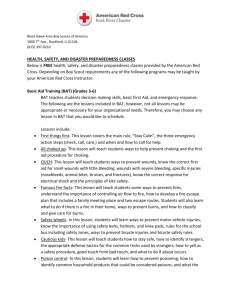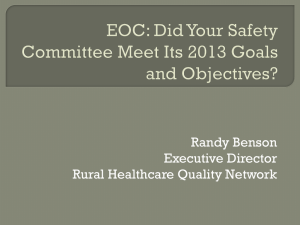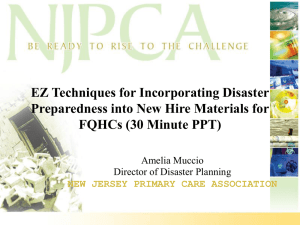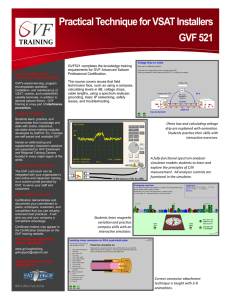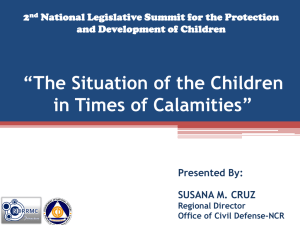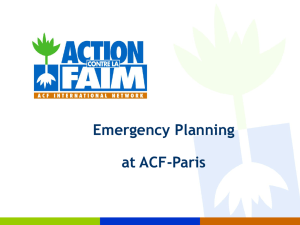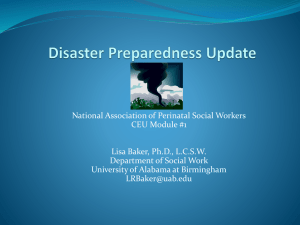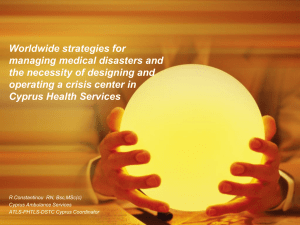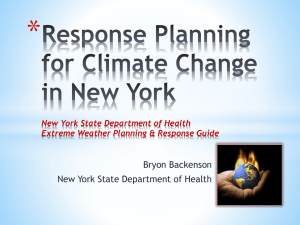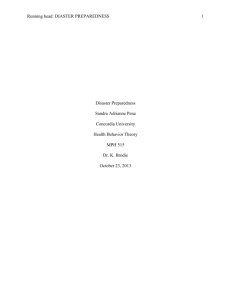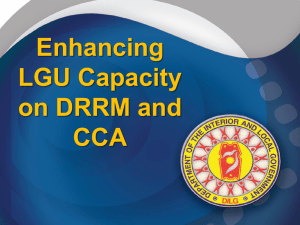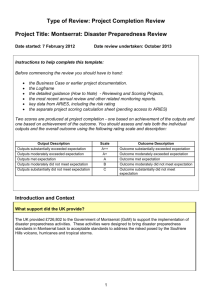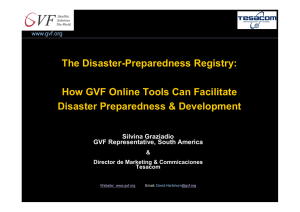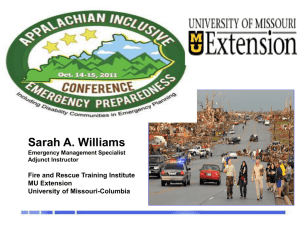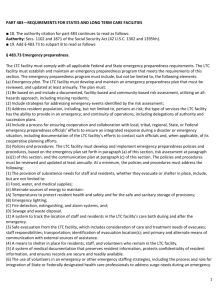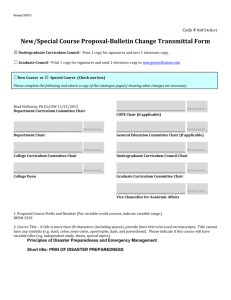Moderator Slides
advertisement
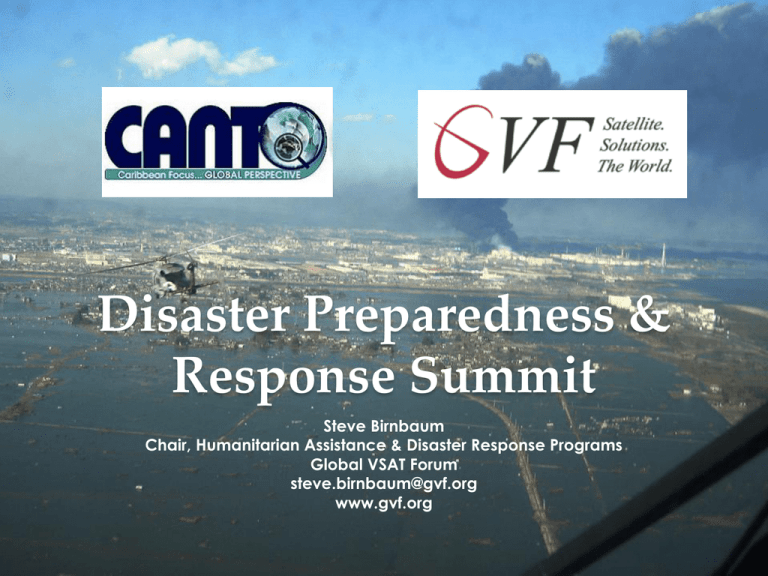
Disaster Preparedness & Response Summit Steve Birnbaum Chair, Humanitarian Assistance & Disaster Response Programs Global VSAT Forum steve.birnbaum@gvf.org www.gvf.org The Global VSAT Forum • Non-Profit Satellite-Sector Association (FSS, MSS, BSS) • 230+ Member Organizations Based Globally • Members Support Millions of Systems Worldwide • GVF Enabling Satcom Service Delivery Through: o Facilitation: Emergency Notifications, Dialogue o Training: VSAT Installation and… o Preparedness: GVF Registry & Installer Database GVF Disaster Preparedness Registry Relationships Distinguished Panel Name Larry Wentz Lynda Geraci Robin Burton Shanti Smith Title Senior Research Fellow, Center for Technology and National Security Policy President Telecom Consultant Program Director Organiztion National Defense University About Business Continuity Inc IFRC / TERA Witt Associates Minister of Telecommunications, Science, Dr. Jerrold Thompson Technology and Industry Gaetan Mentor Advisor Howard Mollison DRP Committee Chairman Joel Trimble President St. Vincent and the Grenadines Telecom Haiti CANTO Haiti Satellite Donnie Vella Kelly O'Keefe Scott Johnson Steve Collar Steve Yablonski Commercial Mobile Alert System Iridium MTN Government Services O3b Networks Globecomm Advisor Manager of Strategic Programs CEO SVP & CTO UN Disaster Definition • 10 or more people killed, OR • 100 or more people reported affected, OR • Call for assistance (exceeded regional response capacity), OR • Declaration of state of emergency by national government 6 Source: http://www.emdat.be/criteria-and-definition The “Whole Community” "Perhaps the most important initiative we must undertake, regardless of the budget environment, is to recognize our efforts are part of an interconnected plan of action. This "Whole Community" approach to emergency management provides the appropriate framework for leveraging the expertise and resources of our stakeholders at all levels, both governmental and nongovernmental. …We know that non-governmental organizations - like faith-based and nonprofit groups - and private sector entities possess knowledge, assets and services that government simply cannot provide. An effective disaster response involves tapping into all of these resources. …Through engaging the "Whole Community," we maximize our limited funding and leverage the capabilities of our partners, who play a critical role in the process.” Craig Fugate, FEMA House Committee on Homeland Security, Subcommittee on Emergency Preparedness 2012 PPD8 – July 6, 2012 By the authority vested in me as President by the Constitution and the laws of the United States of America, it is hereby ordered as follows: Section 1. Policy. The Federal Government must have the ability to communicate at all times and under all circumstances to carry out its most critical and time sensitive missions. Survivable, resilient, enduring, and effective communications, both domestic and international, are essential to enable the executive branch to communicate within itself and with: the legislative and judicial branches; State, local, territorial, and tribal governments; private sector entities; and the public, allies, and other nations. Such communications must be possible under all circumstances to ensure national security, effectively manage emergencies, and improve national resilience. The views of all levels of government, the private and nonprofit sectors, and the public must inform the development of national security and emergency preparedness (NS/EP) communications policies, programs, and capabilities. Full Text: http://1.usa.gov/PlCLga Tampere Convention The Tampere Convention calls on States to facilitate the provision of prompt telecommunication assistance to mitigate the impact of a disaster, and covers both the installation and operation of reliable, flexible telecommunication services. Regulatory barriers that impede the use of telecommunication resources for disasters are waived. These barriers include the licensing requirements to use allocated frequencies, restrictions on the import of telecommunication equipment, as well as limitations on the movement of humanitarian teams. Tampere Convention Signatories Country Date of Signature Barbados Brazil 12 Mar 1999 Chile Colombia Costa Rica Dominica El Salvador Haiti Honduras Nicaragua Panama Peru Saint Lucia Saint Vincent and the Grenadines Uruguay Venezuela 18 Jun 1998 As of January, 2009 Definitive signature (s) ratification, accession (a), acceptance (A) or approval (AA) 25 Jul 2003 a 12 Jun 2008 a 20 Jun 2003 9 Aug 2000 11 Feb 1999 25 Feb 1999 18 Jun 1998 20 Sep 2001 14 Jan 1999 31 Jan 2000 26 Dec 2000 a 18 Apr 2002 18 Nov 1999 5 Mar 2003 27 Oct 2003 14 Aug 2003 a 13 May 2003 3 Apr 2003 13 May 2005 FCC Programs & Capabilities • Alerting o o • Restoration capabilities o o • First ever nationwide test of the Emergency Alert System last November Commercial Mobile Alert System (CMAS)/Personal Localized Alerting Network (PLAN) - A service that allows customers who own an enabled mobile device to receive geographically targeted text-like messages alerting them of imminent threats to safety in their area. Deployable Aerial Communications Architecture – FCC put out a notice of inquiry to get feedback on how aerial devices could assist with communications restoration over a wide area. Key challenges include interoperability, frequency planning, minimizing interference, and coverage. But there is a lot of opportunity to explore this type of technology for wide area restoration. Deployable Enhanced Emergency Radio Station (DEERS) – an FCC concept for a “radio station in a box” that allows for rapid restoration of broadcast radio capabilities in an affected zone. The key is that there may be only one or two foreign language stations in an area, or a remote area with one main broadcaster – if they go down, this truck could be brought in to allow them to continue providing valuable information over the airwaves. Activities on identifying the extent of damage o The Disaster Information Reporting System, or DIRS, is a voluntary, web-based system that communications companies, including wireless, wireline, broadcast, and cable providers, can use to report communications infrastructure status and situational awareness information during times of crisis. This helps streamline requests for assistance and helps us understand the extent of damage. FCC General Thoughts • • • • • • Why pay for preparedness? o o Speed (predeployment, availability to avoid the “rush” when many people need the same goods) Effective Use (allows for testing, regular use – more likely to be effective) o o o o o Redundant (backup capabilities) Available (not subject to congestion, ubiquitous) Diverse (multiple means or paths) Secure (hardened against attack, listening) Interoperable (able to reach multiple devices) o o o Getting life saving information out to the public Coordinating response Giving the public access to emergency services Focus should be on resilience of our communications – operability and interoperability, with capabilities that can be gap filled or restored. There should be multi-jurisdictional sharing in a crisis, or an ability for neighboring jurisdictions to assist each other – flexibility in shared mobile assets with mutual aid agreements What does resilience look like in communications systems? Not every system one uses must have all of these attributes – it is important to think of them as capabilities that an entire communications suite must have Some reasons why communication is important


